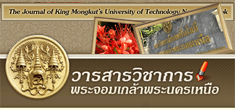Abstract
The influences of the presence of node, cross-sectional size, and moisture content of test specimen on the tensile strength of bamboos were investigated in this research. Two types of Thai’s bamboo, Tong bamboo (Dendrocalamus asper Backer) and Seesuk bamboo (Bambusa blumeana Schult), were chosen for this study. Test specimens were cut from both nodal and inter-nodal zones of a bamboo culm. They were then shaped into small circular cross-sections with diameters of 2, 4, and 6 mm. The test specimens were tested under a direct tensile loading until failure. The results indicated that the presence of a node in the test specimen diminished the bamboo tensile strength. The tensile strength of the nodal zone of Tong bamboo and Seesuk bamboo varied from 178 – 367 N/mm2 and 134 – 242 N/mm2, respectively, which were lower than that of the inter-nodal zone about 1.1 – 2.0 times for both bamboos and these discrepancies reduced with increasing specimen diameter. For the effect of cross-sectional size, a reduced diameter of the test specimen resulted in an increase in tensile strength of bamboo. The test specimen with small diameter (2 mm.) showed the inter-nodal tensile strength of 734 N/mm2 and 490 N/mm2 for Tong bamboo and Seesuk bamboo, respectively, which were 3.65 and 3.14 times higher than the tensile strength of the test specimen with large diameter (6 mm). In addition, the bamboo specimen with lower moisture content exhibited higher tensile strength than that with higher moisture content about 9.4 – 31.7 percent.
Keywords : Bamboo, Tensile strength, Moisture content, Dendrocalamus asper Backer, Bambusa blumeana Schult




